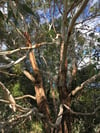Eucalyptus ovata - Swamp Gum
Eucalyptus ovata - Swamp Gum
Habit and Habitat:
Eucalyptus ovata, commonly known as Swamp Gum, is a magnificent native Australian tree celebrated for its stately appearance and valuable contributions to the local ecosystem. As a member of the Myrtaceae family, this evergreen tree is well-adapted to wetlands, marshes, and areas with ample water availability, making it a vital part of the unique Australian landscape.
IUCN Conservation Status:
As of the latest assessment, Swamp Gum is not individually listed on the IUCN Red List. However, it is essential to protect and conserve this significant tree species and its wetland habitats to maintain the ecological balance of the area.
Place in Local Habitat and Ecosystem Distribution:
Swamp Gum plays a crucial role in the local ecosystem, providing habitat and food sources for various wildlife species. Its majestic canopy offers shelter for birds, insects, and mammals, while its nectar-rich flowers attract native pollinators, contributing to the overall biodiversity and ecological health of the area.
Planting Companions:
When considering planting Swamp Gum in a garden, it is vital to recognize its preference for moist and well-draining soil. As a larger tree, it is best suited for spacious gardens or areas where it can flourish without overcrowding other plants. Consider planting it alongside other wetland-loving species, such as Melaleuca and Leptospermum, to create a thriving habitat for native wildlife.
Specific Human and Wildlife Uses:
The Swamp Gum holds cultural significance and has been valued by Indigenous peoples for generations. Various parts of the tree were utilized for practical and ceremonial purposes. The smooth, mottled bark was skillfully fashioned into canoes, shields, and coolamons. Extracts from the leaves of the Swamp Gum were used in traditional Aboriginal medicine. Infusions or poultices made from the leaves were believed to have medicinal properties, such as treating colds, respiratory ailments, and minor wounds. It often features in ceremonies, storytelling, and cultural practices, representing a deep connection to the land and ancestral spirits. The Swamp Gum's flowers were a source of nectar, which served as a food source for Indigenous people and native wildlife. The sweet nectar was collected and consumed directly or used as an ingredient in traditional dishes. Beyond crafting canoes and shields, the Swamp Gum provided raw materials for making various tools and implements. The wood was fashioned into digging sticks, hunting implements, and tools for other daily tasks. The wood of the Swamp Gum was used as firewood for cooking and warmth. Additionally, the fallen branches and leaves provided shelter for small animals and insects in the forest.
Care Instructions:
When planting Swamp Gum in a home garden, ensure it has access to sufficient water, especially during its early establishment. Once mature, it can tolerate periods of drought but will benefit from occasional deep watering during prolonged dry spells. Regular pruning is essential to maintain its shape and manage any potential deadwood.
Size, Height, Width, and Colour of Flower and Leaf:
Swamp Gum is a tall and slender tree that can reach heights of up to 30 meters or more. Its smooth bark may display a stunning mix of colors, ranging from creamy white to shades of pink and gray. The lance-shaped leaves are a vibrant glossy green, providing an attractive contrast against the tree's colorful trunk.
Latin Etymology:
The genus name "Eucalyptus" is derived from the Greek words "eu" (well) and "kalyptos" (covered), referring to the operculum covering the flower bud. The species name "ovata" describes the ovate or egg-shaped leaves characteristic of this species.

